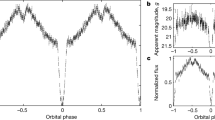The variation of the orbital periods found in high-mass X-ray binaries occurring over time can be explained by two models. According to the first model, orbital decay occurs due to dynamic tidal forces. The second model shows that the change occurs due to the inertia moments of a massive star during its evolution. These models are applied to LMC X-4 and Cen X-3.








Similar content being viewed by others
REFERENCES
R. Giacconi, H. Gursky, E. Kellogg, E. Schreier, and H. Tananbaum, Astrophys. J. 167, L67 (1971).
M. Falanga, E. Bozzo, A. Lutovinov, J. M. Bonnet-Bidaud, Y. Fetisova, and J. Puls, Astron. Astrophys. 577, A130 (2015).
S. V. Chernov, Astron. Lett. 43, 186 (2017).
J. R. Hurley, C. A. Tout, and O. R. Pols, Mon. Not. R. Astron. Soc. 329, 897 (2002).
S. V. Chernov, J. C. B. Papaloizou, and P. B. Ivanov, Mon. Not. R. Astron. Soc. 434, 1079 (2013).
P. B. Ivanov, J. C. B. Papaloizou, and S. V. Chernov, Mon. Not. R. Astron. Soc. 432, 2339 (2013).
A. M. Levine, S. A. Rappaport, and G. Zojcheski, Astrophys. J. 541, 194 (2000).
R. L. Kelley, S. Rappaport, G. W. Clark, and L. D. Petro, Astrophys. J. 268, 790 (1983).
A. M. Levine, S. Rappaport, J. E. Deeter, P. E. Boynton, and F. Nagase, Astrophys. J. 410, 328 (1993).
S. Safi-Harb, H. Ogelmant, and K. Dennerl, Astrophys. J. 456, L37 (1996).
S. V. Chernov, P. B. Ivanov, and J. C. B. Papaloizou, Mon. Not. R. Astron. Soc. 470, 2054 (2017).
S. V. Chernov, J. Exp. Theor. Phys. 127, 73 (2018).
J.-P. Zahn, Astron. Astrophys. 57, 383 (1975).
S. V. Chernov, Astron. Lett. 43, 429 (2017).
W. H. Press and S. A. Teukolsky, Astrophys. J. 213, 183 (1977).
A. S. Endal and S. Sofia, Astrophys. J. 220, 279 (1978).
A. Heger, N. Langer, and S. E. Woosley, Astrophys. J. 528, 368 (2000).
A. Maeder and G. Meynet, Astron. Astrophys. 361, 159 (2000).
D. B. Friend and D. C. Abbott, Astrophys. J. 311, 701 (1986).
J. S. Vink, A. de Koter, and H. J. G. L. M. Lamers, Astron. Astrophys. 369, 574 (2001).
B. Paxton, L. Bildsten, A. Dotter, F. Herwig, P. Lesaffre, and F. Timmes, Astrophys. J. Suppl. 192, 3 (2011).
B. Paxton, M. Cantiello, P. Arras, L. Bildsten, et al., Astrophys. J. Suppl. 208, 4 (2013).
B. Paxton, P. Marchant, J. Schwab, E. B. Bauer, et al., Astrophys. J. Suppl. 220, 15 (2015).
R. H. D. Townsend and S. A. Teitler, Mon. Not. R. Astron. Soc. 435, 3406 (2013).
P. S. Wojdowski, D. A. Liedhal, and M. Sako, Astrophys. J. 547, 973 (2001).
T. M. Tauris and E. P. J. van den Heuvel, arXiv:1401.0941 [astro-ph.SR] (2014).
ACKNOWLEDGMENTS
The author acknowledges the referee for a number of useful comments.
Author information
Authors and Affiliations
Corresponding author
Ethics declarations
This study was supported by the Russian Foundation for Basic Research (contract no. 19-02-00199-a), RAS project KP 19-270 “Investigation of the problems of the origin and evolution of the Universe using observations from the Earth and space” and State order for the science program of experimental and construction studies “Millimetron.”
Additional information
Translated by L. Yungelson
Rights and permissions
About this article
Cite this article
Chernov, S.V. Orbital Decay in High-Mass X-Ray Binaries. Astron. Rep. 64, 425–433 (2020). https://doi.org/10.1134/S1063772920050017
Received:
Revised:
Accepted:
Published:
Issue Date:
DOI: https://doi.org/10.1134/S1063772920050017




